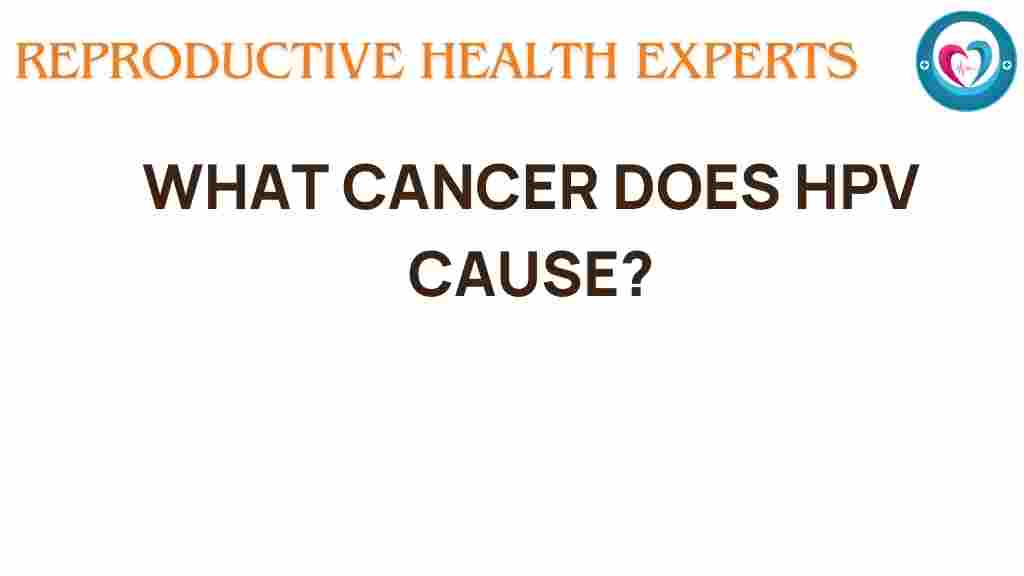Unraveling the Link: What Cancer Does HPV Cause?
Human Papillomavirus (HPV) is one of the most common sexually transmitted infections (STIs) worldwide. While many people associate HPV with genital warts, its implications extend far beyond. In fact, certain strains of HPV are known to cause various types of cancer, particularly cervical cancer. Understanding the link between HPV and cancer is crucial for women’s health, as it can lead to effective prevention strategies and awareness initiatives. In this article, we will explore the connection between HPV and cancer, the health risks involved, and the importance of vaccination and prevention measures.
The HPV and Cancer Connection
HPV is a group of more than 200 related viruses, some of which are classified as high-risk due to their potential to cause cancer. The most notable cancer associated with HPV is cervical cancer, but HPV is also linked to other types of cancer, including:
- Vulvar cancer
- Vaginal cancer
- Anal cancer
- Penile cancer
- Oropharyngeal cancer
According to the World Health Organization (WHO), HPV is responsible for nearly all cases of cervical cancer. In fact, approximately 570,000 new cases of cervical cancer are diagnosed each year, with the majority attributed to HPV infection. Understanding this link is essential for implementing effective prevention strategies.
How HPV Causes Cancer
The process by which HPV leads to cancer is complex and involves several steps:
- Transmission: HPV is primarily transmitted through intimate skin-to-skin contact during sexual activity. This includes vaginal, anal, and oral sex.
- Infection: Once the virus enters the body, it can infect the epithelial cells of the genital area, mouth, or throat. Most HPV infections are asymptomatic and resolve spontaneously within a couple of years.
- Persistence: In some cases, the virus can persist in the body, especially if it is a high-risk strain. This persistent infection can lead to cellular changes.
- Cellular Changes: The high-risk HPV types, particularly HPV 16 and 18, can integrate their DNA into the host cell’s DNA. This integration can disrupt normal cell function and lead to precancerous lesions.
- Cancer Development: Over time, if these precancerous lesions are not identified and treated, they can progress to invasive cancer.
Health Risks Associated with HPV
Beyond cervical cancer, HPV poses several health risks for both women and men:
- Genital Warts: Some low-risk HPV types can cause benign growths called genital warts, which can be uncomfortable or distressing.
- Other Cancers: As mentioned earlier, HPV is linked to several other cancers, which can impact both genders.
- Psychological Impact: The stigma around STIs can lead to anxiety and depression for those diagnosed with HPV.
Prevention Strategies
Preventing HPV infection is crucial for reducing the risk of cancer. Here are effective strategies:
1. Vaccination
One of the most effective ways to prevent HPV-related cancers is through vaccination. The HPV vaccine is recommended for preteens aged 11-12, but it can be administered up to age 26. Here are some key points:
- The vaccine protects against the most common high-risk HPV strains.
- Vaccination is safe and effective, with the potential to significantly reduce cervical cancer rates.
- Even individuals who are already sexually active can benefit from vaccination, as it may protect against strains they have not yet encountered.
2. Regular Screening
For women, regular cervical cancer screenings (Pap smears and HPV tests) are crucial. These tests can detect precancerous changes in the cervix, allowing for early intervention. Recommendations include:
- Women aged 21-29 should have a Pap smear every three years.
- Women aged 30-65 should have a Pap smear combined with an HPV test every five years or a Pap smear alone every three years.
3. Safe Sexual Practices
Practicing safe sex can significantly reduce the risk of HPV transmission. Consider the following:
- Use condoms consistently and correctly.
- Limit the number of sexual partners.
- Engage in mutual monogamy with a partner who has been tested for STIs.
4. Awareness and Education
Raising awareness about HPV and its link to cancer is essential. Educational initiatives can:
- Inform individuals about the importance of vaccination.
- Encourage regular health check-ups.
- Reduce stigma associated with STIs.
Common Myths About HPV
There are many misconceptions surrounding HPV that can hinder prevention efforts. Here are a few common myths:
- Myth: Only promiscuous individuals get HPV.
- Myth: HPV is only a concern for women.
- Myth: You can tell if someone has HPV by looking at them.
Dispelling these myths is vital for promoting a better understanding of HPV and its health risks.
Troubleshooting Tips for HPV Management
If you or someone you know is diagnosed with HPV, consider the following tips:
- Stay Informed: Learn about your specific type of HPV and its potential health risks.
- Follow Medical Advice: Adhere to your healthcare provider’s recommendations for screenings and treatments.
- Support Systems: Seek support from friends, family, or support groups to manage the emotional aspects of an HPV diagnosis.
Conclusion
Understanding the link between HPV and cancer, particularly cervical cancer, is essential for promoting women’s health and preventing the associated health risks. Vaccination, regular screenings, and safe sexual practices are critical components of an effective prevention strategy. Raising awareness and educating the public about HPV can lead to better health outcomes and reduced stigma surrounding sexually transmitted infections. For more information on HPV and cervical cancer, check out the American Cancer Society.
By prioritizing awareness, prevention, and vaccination, we can work together to unravel the complexities of HPV and reduce its impact on public health.
This article is in the category Prevention and created by ReproductiveHealthExperts Team
